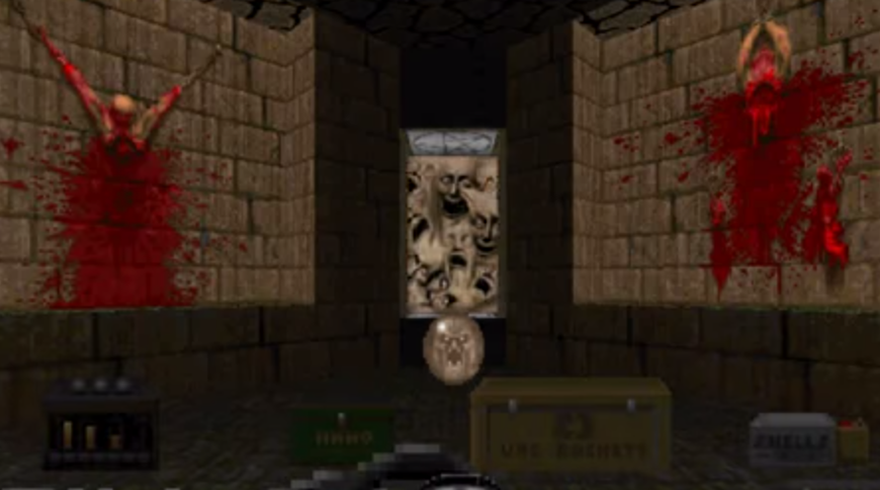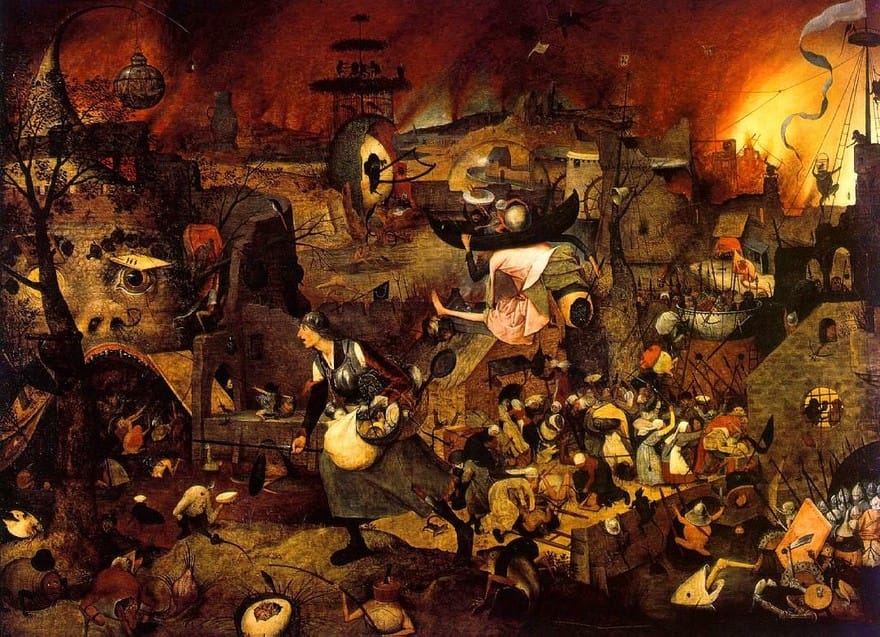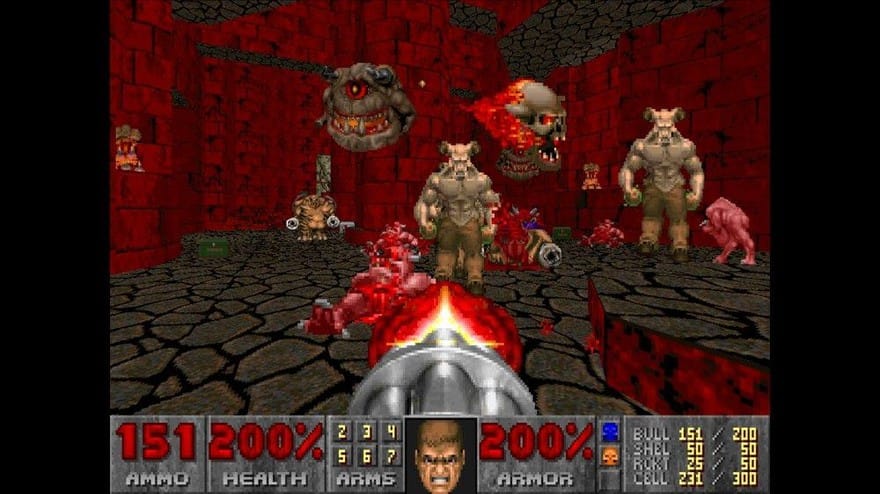Going to Hell: DOOM II and the Descent Into Chaos

This is an exclusive, original essay from the editors of SHOOTER, a collection of critical essays about games with guns. The full book, which features work from 15 writers, hand-drawn illustrations, and a foreword by Clint Hocking, is available here.
///
The 13th level in DOOM II is called “Downtown.” It’s big, set in a bizarre facsimile of an urban centre where the streets are rendered in lumpy, oatmeal-textured stonework, red brick-work apartment facades are entered through pneumatic metal doors, and the skyline is filled with blazing fires peeking out behind a haze of apocalyptic smog. “Downtown” is, in many ways, the quintessential level of id Software’s 1994 sequel. Its networks of hidden passages, demon-filled corridors, and well-concealed keycards may echo superficial elements from the first DOOM, but the core of its design is a marked departure from what came before.
“Downtown” is a prime example of the way DOOM II differs from its predecessor. Unlike the winding corridors of the first game’s “Knee Deep in the Dead” episode or even the hellish labyrinths composing the latter levels of both DOOM games, “Downtown” isn’t a single-path romp through corridors, but rather a vast, open-air and open-ended level with no clear progression from the start. This isn’t too noteworthy in and of itself; a map like “Mount Erebus” in Episode 3 of DOOM was a similar arena-style level—one of the only in the game, in fact. But “Downtown” is interesting in that it’s one of the only places players visit in the DOOMiverse that seems to be trying to mimic a real place. The fiction of the DOOM series is such that the games have almost always been protected from the necessities of real-world fidelity. In DOOM, players move through a military base on a moon of Mars to another military base hovering just over the surface of Hell to traveling through Hell itself. In terms of real-world architecture, the game starts off in the realm of sci-fi and ends up positively fantastical.

In “Downtown,” however, we get something altogether different. Instead of the developers sharing their vision of what they think a “Nuclear Plant” or “Refinery” would look like on a Martian base, they’re trying to evoke imagery that the player already carries with her. id Software is in a very literal way bringing “Hell to Earth,” and “Downtown” is one of the clearest examples of this. There are other maps in DOOM II—“Factory,” “Industrial Zone,” and even “Suburbs,” which are clearly meant to have at least a passing relation to their real-world counterparts, but “Downtown” is the only level that appears to be trying to reproduce a specific setting. This may not seem like much, but from a design perspective, introducing setting is one of the key elements of establishing something very unDOOM-like: a narrative.
DOOM is famous for not having much of a story. You’re a space marine, you kill demons from Hell, that’s about it. The player finds herself fighting through Martian science complexes in the first game, encountering an array of monsters ranging from floating, electricity-vomiting cacodemons and spiky brown imps to muscular, snortling demons and super-buff minotaurs called hell knights. These are the vanguard forces of Hell, loosed through malfunctioning teleportation devices created by the Union Aerospace Corporation. Doomguy, a member of the security forces assigned to oversee the UAC scientists, shreds through this opposition on a journey through the research labs installed on Mars’ moons and, finally, the depths of Hell itself. Not exactly Pulitzer material.
But it would be a mistake to conflate the series’ lack of any real plot with the idea that DOOM games aren’t “about” anything. DOOM is very much a game about a descent through chaos and Hell—this story just happens to be thematic rather than expository, and is told through progressive level construction rather than dialogue. This is made clear through its embrace of Hell as not just a place of fire and brimstone, but of a higher form of fear as well: a kind that traces its roots to the theology of Western Christianity.

Rather than an inferno conforming to Dante’s vision—one where Hell is divided and subdivided into circles, rings, and ditches—DOOM II looks to the senselessness of something like a Hieronymus Bosch painting for inspiration. If god is order and the influence of Heaven one of words and law, then the antithesis of this is a Hell devoid of reason. From the viewpoint of many Christian theologians, Jesus represents the ordering influence within the Holy Trinity (or the Logos: the original Greek for “word, reason, and/or discourse”). This is in itself a concept related to the Old Testament creation story, wherein the nothingness of the universe is ordered into the heavens and earth—made comprehensible, essentially—through god’s Word. A core tenant of Christianity is the link between the Trinity and reason, the primacy of the Logos established within the Gospels: “In the beginning was the Word, and the Word was with God, and the Word was God. The same was in the beginning with God. Things were made by him; and without him was not any thing made that was made” (John 1:1-3, King James Bible).
Without going too deep into the nuances of complicated and ancient theological and philosophical arguments, it’s enough to understand that the American conception of Hell id Software draws on in DOOM‘s creation is one informed, consciously or not, by a religion where the absence of god is characterized by an absence of order. More than the outward trappings of the underworld—inverted crosses, pentagrams, boiling lava, and snarling demons—the real definition of Hell, in the Western cultural tradition, comes from its lack of sense. Without the ordering of the world, there is only chaos. This concept extends into our language itself. A word like pandemonium—a term denoting complete disorder—comes from Milton’s portrayal of Hell’s capital; an idiom like “it all went to hell” is used to denote the breakdown of logic or protocol. We may think most often of Hell as a physical place, populated by monsters and the shrieks of the damned, but it’s impossible to forget that, more than this, it’s the loss of order that truly defines it.
DOOM is very much a game about a descent through chaos and Hell.
DOOM II‘s structure and the progression of its architecture conforms entirely to this perception. Picking up from its predecessor’s post-game stinger—a still shot of an impaled bunny and an Earth under demonic invasion—Hell on Earth‘s action shifts to a setting that is meant to resemble our home planet, but looks, for the most part, an awful lot like the UAC’s Martian science complexes. What’s most striking, though, is not the manner in which DOOM II models Earth, but how its growing focus on the influence of Hell is felt. The story, such as it is, sees the forces of evil making even greater inroads on their apocalyptic campaign, spilling out of portals connecting Hell and Earth (as seen in “Downtown”). Fittingly, the entirety of DOOM II‘s design compliments its minimalist plot in a fairly profound way, reflecting the influence of the underworld as a disordering of all logic.
As the player moves beyond the first few levels of the game, the environments begin to grow in complexity, the relatively straightforward, logical level structure that defined much of DOOM ballooning outward and twisting in on itself to form increasingly complex mazes. Pull up the game’s wireframe map after completing DOOM II‘s introductory stages and it becomes immediately clear that id Software’s sequel is built upon a purposely confusing foundation. Small rooms are hidden on opposite ends of sprawling levels peppered with teleporters; the keycards and skulls needed to unlock new areas are tucked away in barely noticeable corridors. Where much of DOOM was carefully laid out to encourage progression—the vast majority of the levels make it clear where the player needs to explore in order to keep moving and discovering hidden secrets is an optional activity—DOOM II is meant to disorient.
This is all in line with the descent into Hell outlined by the game’s story. DoomGuy, after discovering the portal connecting Earth and the demon’s home, ventures onward in order to stop the invasion. Once on the other side, the environmental complexity and enemy difficulty ramps up even further. As the player heads toward her ultimate confrontation with The Icon of Sin, the devilish overlord of DOOM‘s demonic army, the game world itself compensates for a lack of explicit storytelling to reflect the growing proximity of id’s satanic stand-in. The abstracted environments become increasingly bizarre, enemies begin to surprise the player more often (“monster closet” ambushes are one of the series’ favorite tricks), and the difficulty of combat ramps up in punishing fashion.

Despite being a direct sequel and recycling many enemies, weapons and sounds, DOOM II paradoxically adheres to the guiding design paradigm of its predecessor while forging its own path, eschewing the lessons of its progenitor at the same time. Unlike the former game, which dumped players on a military base nearly 50 million miles away, DOOM II brings the danger to our doorstep—literally “Hell on Earth.” The tension the level designers grapple with is thus: the balance between creating spaces that are familiar enough to believably represent Earth, and creating spaces that are fun to play in a DOOM game.
The resulting synthesis has produced some incredibly interesting maps alongside other, frankly bizarre ones. “Entryway,” for example, the game’s opening level, is a concise series of hallways that could easily belong in any real building. On the opposite end of the spectrum, maps like “The Chasm” or “Barrels of Fun” are entirely abstract places, created to emphasize specific gameplay concepts rather than settings or themes. (“The Chasm,” for example, is the most platforming-heavy title in the entire DOOM series, while “Barrels of Fun” seems to have been designed solely as a playground to blow up the game’s trademark explosive barrels.)
This is in stark contrast to the first DOOM’s levels, which are mind-numbing in their efficiency. The game is a racetrack or a carnival ride, laid out in such a way as to naturally guide players through its hallways and onto the next setpiece. In contrast, DOOM II is a haunted house—short of knowing where to go or what to do, players are often left intentionally disoriented, feeling lost, overpowered, and small. Compare maps like DOOM‘s“Computer Station,” which is a tightly woven guided tour of corridor progression, key hunting, and calculated backtracking, with a map from DOOM II like “Monster Condo” or “Gotcha!”, both of which require players to traverse hidden teleporters and secret passages. On one side is the order of human logic; on the other, the abstraction and chaos of the hell enveloping the game environment.
DOOM II is meant to disorient.
The level of difficulty separating the two games also reflects the influence of Hell. Although the game is often billed as “cyber horror,” DOOM actually at no point tries to get in the way of its players’ success, as many horror games do. Rooms may be filled with demons, but the weapon location and ammo dispersion is such that, short of a few of the game’s later levels, players are never at any real danger of being defenseless. It is a game of pure momentum, and its environmental structure reflects that. John Romero, chief level designer of DOOM‘s first episode, constantly provided signposts and hints to players. If you see enemies milling around outside a window, you know to look for a door out. A wall cut-out showing a keycard elevated on a pedestal becomes the player’s obvious objective.
Even when DOOM is tricking its players, it’s doing so in a way that is logical. The goal is to surprise and exhilarate, but not stymie. The famous “monster closet” technique, where enemies would appear out of teleporters or secret compartments, provide the game’s central adrenaline-producing moments, yet their presence is almost always broadcast—the player knows that the chaingun sitting on a pedestal or the keycard waiting in an empty room is going to trigger the next challenge. In DOOM II, the surprises stop being friendly. “Courtyard,” for example, features many monster closest-style traps, but unlike the example set in DOOM, these are designed to take the player completely off-guard, leaving her in a position of weakness rather than one of strength. In other words, the internal logic of DOOM is guided by the understanding between player and developer that, if the audience follows along, they will come out unscathed. DOOM II on the other hand makes no such promises. It’s less an invitation to experience a fantastic ride and more a challenge to overcome an immense, appropriately hellish series of obstacles.
It’s clear that a shift occurred in DOOM II. What’s less clear is whether this was a planned objective of the developers, or an inadvertent consequence of the level design being taken on by American McGee rather than John Romero. Maybe id wanted to create a world that was more hostile, more confusing, and more chaotic the second time around, or maybe McGee was just exercising his own sensibilities. Regardless, the end result is a sequel that manages to marry its plot and design in a subtle but deeply effective manner. More than its audiovisual aesthetic—more than its grotesque demons, gore, and midi metal soundtrack—it’s the embrace of abstraction and the loss of the previous game’s sense of logic that shows DOOM II‘s commitment to the Hell it’s so invested in portraying.
///
Body image of Hieronymus Bosch painting acquired via Wikipedia Commons.



